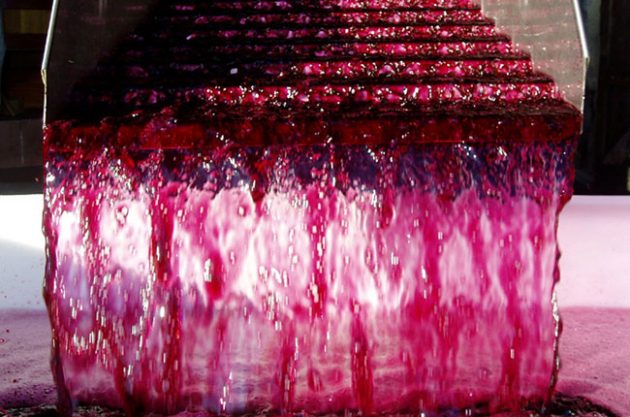
Anson: Bordeaux’s ‘Enfant Terrible’
Jane Anson meets a ‘rebel winemaker’ of Bordeaux and finds out why local wine officials have filed court action against him.
Dominique Léandre Chevalier: Bordeaux’s ‘Enfant Terrible’
The Monopole de Bord’eaux Inférieur. That’s what the label proudly proclaims, above a photograph of a vineyard on the Ile de Patiras.

The label. Credit: Jane Anson.
The vines in question are within the AOC Bordeaux/Bordeaux Supérieur appellation, on one of the small Garonne islands that lie pretty much halfway between the banks of Pauillac and Blaye. And their apparent ‘demotion’ on the label, as you might expect, has caused something of a stir in the region over the past few weeks.
Dominique Léandre Chevalier, the winemaker who is responsible, is smiling at me broadly. We are tasting through a selection of his 24 different wines that include a 100% ‘Blanc de Noir’ from Cabernet Sauvignon, in both sparkling (pet-nat or méthode ancestral) and still versions, made both with and without malolactic fermentation, and with or without oak ageing.
Next up is an oxidized sous-voile-style white made from 100% Merlot. In the garden just outside our tasting area is an oak vat where the first year of a solera system wine is beginning its journey. Others in the range include a 100% Malbec, an ungrafted Petit Verdot and Merlot reds from plantings at both 11,000 vines and 33,000 vines per hectare (the average in his area is somewhere close to 5,000).
I guess what I’m saying is this is not a man likely to be overly worried by the reaction to his Bord’eaux Inferieur joke.
‘It simply seemed impossible for me to label the wine AOC Bordeaux Supérieur when the vines are planted at between 3,000 and 4,000 vines per hectare, when I compare them to my vines in Blaye that are planted at 5,000, 10,000, 11,111 and 33,333 per hectare. I know the quality improvement of high density plantation, and I wanted to emphasise that my Ile de Patiras wines are fruity, fresh and meant for early consumption. It is not supposed to be taken too seriously’.
It was, however, taken seriously by the officials at the Bordeaux wine syndicate, as you might expect. The Merlot-dominant wine was being sold exclusively through French supermarket Monoprix at its September wine fair, as a Vin de France (he didn’t have quite the chutzpah to go for that name under the AOC Bordeaux certification).
It has now been removed from sale (or, as Léandre-Chevalier puts it, ‘the promotion has now ended and I have plenty of other wines to concentrate on’) pending a court case.
‘The wine comes from vines on the Ile de Patiras in the Gironde estuary,’ says Eric Morain, the lawyer representing Léandre-Chevalier and a little more on-message than his client. ‘They are on the lowest-lying part of the Estuary, right on the water, hence the use of the wordplay (in French, Superieur and Inferieur can mean higher and lower). It is meant to entertain not to mislead’.
‘Even if word play, clearly the use of the word Bordeaux on a Vin de France wine, that should be without specific geographic reference, is misleading,’ was the reply of Florian Reyne, director of the Bordeaux/Bordeaux Supérieur wine syndicate given to the local press.
Let’s back up just a little at this point. Dominique Léandre Chevalier is a winemaker who I have been reading about for years. Known as – let me surprise you – the rebel winemaker or ‘enfant terrible’ of Bordeaux, his estate is more usually written as DLC (luckily his actual initials, thereby neatly avoiding I expect another law suit).
I drove up to see him this week, through the snaking roads of Bourg and Blaye to the village of Anglade, where the DLC sign sits on a road just set back from the Estuary. The land is higher here than on the Médoc side, with some of the same gravelly soils, coupled with clay and limestone, and particularly this section is home to many fine terroirs that have fallen out of fashion but were once highly sought after.
I can’t help feeling that DLC should be in Bourg – the neighbouring appellation that is famous for going its own way and refusing to be part of the Côtes de Bordeaux grouping – but instead it is no doubt doing great work for the marketing of Blaye, even if over half of DLC wines are bottled under Vin de France.
‘I can make appellation wines,’ he says, welcoming me fresh from a morning spent (very amicably apparently) with the fraud office in connection to the Patiras wine, ‘although what is on the label is less important to me than the creativity of producing things that interest me’.
That hardly needs saying when you look at his range of bottles, but Léandre-Chevalier is more than clever marketing, and is a winemaker truly worth getting to know. The estate, originally known as Château le Queyroux, has been in his family for three generations and now broken up into smaller parts between him and his two sisters. He started his career as an ornamental plasterer with the Compagnons de Tour de France, an organisation of craftsman and artisans that dates back to the Middle Ages and producers some of the most highly-skilled specialists in the French building trade.
‘I only became interested in wine in my late 20s, when I began to see how it was part of my own heritage and history. But I always knew that I would have to do things my way’.
This has meant, among other things, concentrating initially on only 3.2 hectares of vines, that he works entirely with shire horses and a hand-drawn plough, with zero chemicals used (‘but I am not certified organic, because it feels dishonest when neighbouring estates use chemicals’). More recently he has taken over from his sister on the Ile de Patrias and has bought a separate estate in his village that he has renamed Jardin sur Anglade to make what he terms ‘creative wines’ (that include the Blanc de Noirs, among others).
This is a winemaker who is constantly questioning – he has bottled the exact same wine under both Vin de France and Blaye Côtes de Bordeaux to draw attention to the unfair price ceiling that the Côtes suffer from, and has bottled others in Bordeaux and Burgundy bottles to test consumer perceptions. I enjoyed tasting through the wines, and they left me wondering why more winemakers in Bordeaux are not more creative with the local grapes.
Will he win his court case? It seems unlikely. But he’ll add to the myth of the enfant terrible along the way, which perhaps amounts to the same thing.
Dominique Léandre Chevalier: Wines to Try
DLC Perles de Gironde Vin de France 2015
Méthode ancestrale, meaning just one fermentation in bottle, capped to capture the CO2. No addition of sugar or liquer d’expedition and unoaked. This is from 100% Cabernet Sauvignon grapes, and is ‘vinous’ in flavour, surprisingly well structured with gentle bubbles. Full of flavour, a good discovery and hugely refreshing to find someone making this style in Bordeaux.
12%abv. 88.
DLC Blanc Noir Vin de France 2016
A white wine made from 100% Cabernet Sauvignon grapes, unoaked (this is also the base wine for the bubbles). Clean, crisp, a little thin though the mid palate but fresh with good florality.
86.
DLC Blanc Noir Vin de France 2015
100% Cabernet Sauvignon separated from the skins to make a white wine, but here oaked and with lees stirring to add weight. He suggests that consumers shake the bottle before opening to get the lees back in suspension, emphasing the ‘natural wine’ feel. I would never identify this blind, I can tell you that right now. Almost Chardonnay like in terms of texture, although more rich pear than citrus, it has weight and creaminess with a touch of salinity, even bitterness, on the finish.
89.
Le Joyeau de Chateau le Queyroux AOC Cotes de Blaye 2011
Here you see him flexing his winemaking muscles in a more serious wine. Planted at 10,000 vines per hectare, with integral vinification and ageing in new oak barrels, this is a blend of old vine Merlot, Cabernet Sauvignon and Petit Verdot, 100% free run juice so no press used. You find again a touch of salinity on the finish, fleshing out gently brambled fruits and soft woodsmoke. This is an excellent wine that also delivered in the 2013 vintage that we tried. A good calling card.
93.
